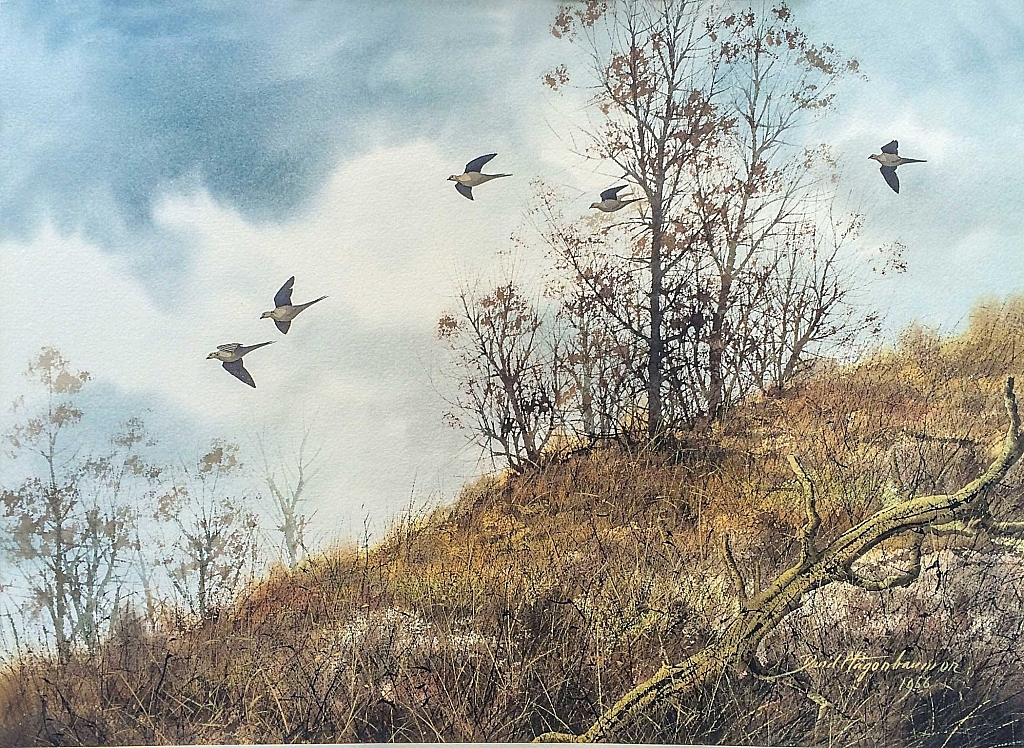
Hagerbaumer’s lifework also includes his books, Selected American Game Birds (1972), comprising 26 plates of 29 species in their landscapes, with the texts hand-calligraphed by Sam Lehman; his copiously illustrated autobiography, The Bottoms, printed in a limited edition of 250 by Amwell Press, in 1987; and Waterfowling These Past 50 Years—Especially Brant (1998), which celebrates a lifetime of hunting these black geese that frequent eelgrass-rimmed lagoons and shallow bays. He also illustrated books by Worth Mathewson, including Big December Canvasbacks (1997), Best Birds (2000), and Band-tailed Pigeon (2005), a personal favorite he knew well from carving out of cedar and individually painting spreads of up to 50 birds used to decoy flocks that frequented the grain elevators of coastal Washington State, where he was living.
Hagerbaumer’s natural sense of composition stems from observing nature’s own eye-pleasing balance between horizon and sky…
Although Hagerbaumer was basically self-taught (one doubts he could have endured the restraints of an academy education), he wasn’t uninstructed or uninfluenced. His mentor, outdoor watercolorist Roy M. Mason (1886–1972), passed on his own hard-earned learnings about technically mastering the medium, including using a hairdryer to govern unruly watercolors. Mason taught him about English-made Winsor & Newton pigments, and may have suggested his palette of burnt sienna, earthy umbers, leafy Hooker’s green, and cobalt blue that stains less harshly while creating interesting textures. Perhaps the award-winning Mason, whose “real” job was designing labels and embossed seals for his father’s manufacturing company, set the example of utilizing the best sable brushes, as well as the sharp-tipped, flexible-bodied sumi brushes whose waterholding capacity is vital to Japanese calligraphy and painting. In fact, sumi brushes are described as helping the artist express the Ch’i, or spirit, of nature, rather than its photographic detail, which best describes Hagerbaumer’s oeuvre. Still, his sketches testify to careful comparisons of the different summer plumages of rock, willow, and white-tailed ptarmigan, and the coloring and contour of rallidae beaks.
But Hagerbaumer’s spirit is more hibernal—derived more from thousands of frigid duck blinds—than Mason’s Homeresque recall of the patterns in the landscape of summer colors and summer light. Hagerbaumer stuck to what he knew best: the shapes and markings of flying, landing, or exploding game birds that instantaneously identify the species to the hunter’s eye, distinguishing almost instinctively between redheads and canvasbacks or ringnecks and scaup.
Hagerbaumer’s natural sense of composition stems from observing nature’s own eye-pleasing balance between horizon and sky, and endows his work with poetic power. The hunter is strictly offstage, present only through the spectacle unfolding before his eyes: elegantly colored snow geese streaming in counterpoint to scudding banks of gray and yellow stratocumulus clouds; a solitary snipe soaring over the mud flats or marshes attaining a tenuous visual apex against a milky, translucent sky; or a diagonally descending succession of pintails in every stage of lowering their landing gear.

